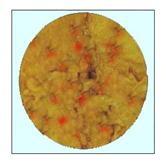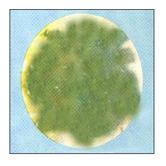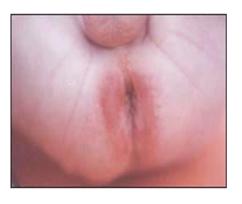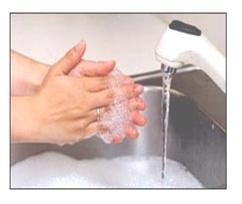신생아 전염성 설사(신생아 감염성 설사), Infectious diarrhea in newborn infants
- 만삭으로 태어난 건강한 신생아들의 대부분은 거의 물과 비슷하게 물똥을 정상적으로 질게 눈다. 이런 신생아들의 정상적 변을 설사라고 하지 않는다.
- 신생아들은 박테리아 감염이나 바이러스 감염 등에 대항할 수 있는 저항력이 원래 미약하다.그래서 신생아기 이후 영유아들이나 학령기 아이들, 또는 성인들에게는 잘 감염되지 않는 박테리아이나 바이러스 등에 위장이 잘 감염되어 신생아들에게 심한 위장염이 생길 수 있다.
- 박테리아 감염이나 바이러스 감염으로 신생아 위장염이 생기면 짧은 시간 내에 설사를 심하게 할 수 있고 심하게 탈수될 수 있다.
- 신생아가 먹는 인공영양 성분 우유 단백질 알레르기로 설사를 할 수 있다.
- 신생아 위장염을 일으키는 박테리아나 바이러스는 일반적으로 감염성이 강력해서 같은 신생아실에 있는 다른 신생아들에게도 쉽게 감염될 수 있다.
- 특히 신생아 대장균 위장염을 일으킨 병원성 대장균은 감염성이 강력해서 때로는 같은 신생아실에 입원한 여러 신생아들이 동시 감염성 대장균 위장염에 걸릴 수 있고 그로 인해서 설사를 할 수 있다([부모도 반의사가 되어야 한다-소아가정간호백과]-제 1권 소아청소년 응급의료-설사 참조, 제9권 소아청소년 소화기 질환-대장균성 설사)
- 특히 대장균, 살모넬라균, 파라티프스균, 이질균과, 황색 포도상구균 등의 병원체는 신생아 박테리아 설사의 주 원인이 된다.
- 바이러스 상·하 호흡기 감염병을 일으켰던 바이러스로 인해 신생아 위장염이 생길 수 있고 각종 장 바이러스 감염으로 인해서도 신생아 위장염이 생겨 그로 인해 신생아가 설사를 하기도 한다.

사진 164.감염성 위장염으로 생긴 혈변
Copyright ⓒ 2011 John Sangwon Lee, M.D. FAAP

사진 165.감염성 위장염으로 생긴 설사변
Copyright ⓒ 2011 John Sangwon Lee, M.D. FAAP

사진 166.설사 변.
변의 형태가 없고 소화되지 않은 음식물이 나오고 물갈이 짙은 변을 설사변 이라고 한다.
Copyright ⓒ 2011 John Sangwon Lee, M.D. FAAP
| 신생아 전염성 설사의 증상 징후 |
- 신생아 위장염을 일으킨 원인과 정도에 따라 설사와 증상 징후가 다르다.
- 여기서 대장균 위장염으로 생긴 신생아 설사에 대해 주로 설명한다.
- 신생아에게 대장균 위장염이 생기면 잘 먹던 모유나 인공영양을 통 먹지 않는다.
- 초기엔 어딘가가 아픈 것같이 보이고 보채면서 미열 내지 고열이 난다.
- 위장에 가스가 많이 차서 배가 팽만해지고 묽고 푸른 설사 변을 하루에 여러 번 볼 수 있고 때로는 설사 변에 점액과 피가 섞여 있다.
- 심할 때는 불과 몇 시간 내에 심하게 탈수될 수 있고 탈수가 되면 비정상적으로 잠만 계속 자고, 힘이 없어서 전신이 축 늘어질 수 있다.
- 이 병이 곧 적절히 치료되지 않으면 심히 탈수되고 쇼크에 빠지고 사망할 수 있다.
| 신생아 전염성 설사의 진단 |
- 병력, 증상 징후, 진찰소견 등을 종합하여 이 병이 의심되면 피, 소변, 설사 변, 척수액 등을 채취하여 피검 물로 세균배양검사 등을 해 설사의 원인균을 찾아 진단한다.

사진 167.설사변으로 인한 항문 주위염
Copyright ⓒ 2011 John Sangwon Lee, M.D. FAAP

사진 168.특히 감염성 설사를 예방하기 위해 손을 자주 씻어야 한다.
Copyright ⓒ 2011 John Sangwon Lee, M.D. FAAP
| 신생아 전염성 설사의 치료 |
- 적절히 속히 치료해 주지 않으면 사망할 수 있다.
- 이 병이 의심될 때는 즉시 병원에 입원해서 집중적으로 치료해야 한다.
- 병원성 대장균은 주위에 있는 다른 신생아들에게도 쉽게 감염될 수 있다.
- 이 병을 일으킨 병원성 대장균이 다른 신생아들에게 감염되지 않게 이 병을 앓는 신생아를 다른 신생아들로부터 즉시 격리시켜야 한다.
- 포도당 전해질용액 정맥주사로 탈수를 예방하고 적절한 항생제로 치료한다.
- 신생아가 어디서 이 균에 감염되었는지 조사한다.
- 병원성 대장균은 비위생적이고 밀집한 신생아실에 있는 신생아나 불결한 주거생활을 하는 신생아에게 잘 감염된다.
- 이런 이유로 특히 신생아를 돌보기 전 및 중 손을 항시 깨끗이 씻어 이 병을 예방해야 한다.
Infectious diarrhea in newborn infants
• Most healthy newborns born to full term hold water normally, almost like water. Normal stools in these newborns are not called diarrhea.
• Newborns have a weak resistance to bacterial or viral infections. So, infants, school-age children, or adults after the newborn period can easily infect the stomach with bacteria or viruses that are difficult to infect, causing severe gastroenteritis in newborns. this can happen
• Gastroenteritis in newborns due to bacterial or viral infection can cause severe diarrhea and severe dehydration within a short period of time.
• A newborn baby may have diarrhea due to an allergy to milk protein.
• Bacteria or viruses that cause neonatal gastroenteritis are generally highly contagious and can easily infect other newborns in the same neonatal unit.
• In particular, pathogenic E. coli, which causes neonatal E. coli gastroenteritis, is highly contagious, and sometimes several newborns admitted to the same neonatal unit can develop co-infectious E. coli gastroenteritis, which can lead to diarrhea ([Parents must also become at least the half -doctors – Families of children) Encyclopedia of Nursing]-Vol. 1 Emergency Medical Care for Children and Adolescents-Diarrhea, Vol. 9 Gastrointestinal Disorders in Children and Adolescents-E. coli Diarrhea)
• In particular, pathogens such as Escherichia coli, Salmonella, Paratyphoid, Shigella, and Staphylococcus aureus are the main causes of bacterial diarrhea in newborns.
• Viruses The virus that caused upper and lower respiratory tract infections can cause neonatal gastroenteritis, and various enterovirus infections can also cause neonatal gastroenteritis, resulting in diarrhea in newborns.
Picture 164. Bloody stool caused by infectious gastroenteritis Copyright ⓒ 2011 John Sangwon Lee, M.D. FAAP

Picture 165. Diarrhea caused by infectious gastroenteritis Copyright ⓒ 2011 John Sangwon Lee, M.D. FAAP

Picture 166. Diarrhea stool. Diarrhea is a form of stool with no form of stool and undigested food and dark, watery stools. Copyright ⓒ 2011 John Sangwon Lee, M.D. FAAP
Symptoms Signs of Infectious Diarrhea in Newborns
• Diarrhea and symptoms differ depending on the cause and severity of neonatal gastroenteritis.
• Diarrhea in newborns caused by E. coli gastroenteritis is mainly discussed here.
• If a newborn develops E. coli gastroenteritis, do not eat breast milk or artificial nutrition that was well-fed.
• At first, it looks like something is hurting, and there is a slight fever or high fever.
• Your stomach is full of gas, causing bloating and you may have watery, blue diarrheal stools several times a day, sometimes with mucus and blood in the diarrheal stools.
• In severe cases, you can become severely dehydrated within just a few hours. If you become dehydrated, you can sleep abnormally and continue to sleep, and your body may droop due to lack of strength.
• If this condition is not treated promptly and properly, it can lead to severe dehydration, shock and death.
Diagnosis of neonatal infectious diarrhea
• If the disease is suspected by combining the medical history, symptom signs, and examination findings, blood, urine, diarrheal feces, spinal fluid, etc. are collected, and bacterial culture is performed with the specimen to find and diagnose the causative bacteria.

Picture 167. Perianalitis due to diarrhea Copyright ⓒ 2011 John Sangwon Lee, M.D. FAAP

Picture 168. Hands should be washed frequently, especially to prevent infectious diarrhea. Copyright ⓒ 2011 John Sangwon Lee, M.D. FAAP
Treatment of neonatal infectious diarrhea
• Death can result if not treated promptly.
• When this disease is suspected, you should immediately go to the hospital for intensive treatment.
• Pathogenic E. coli can easily infect other newborn babies in the vicinity.
• Newborns with this disease should be immediately isolated from other newborns to avoid infecting other newborns with the pathogenic E. coli that caused the disease.
• Prevent dehydration by intravenous injection of glucose electrolyte solution and treat with appropriate antibiotics.
• Investigate where the newborn is infected. • Pathogenic E. coli is easily transmitted to newborns in unsanitary and dense neonatal rooms or to newborns living in unclean housing.
• For this reason, you should always wash your hands thoroughly before and during babysitting, especially to prevent this disease.
출처 및 참조 문헌 Sources and references
- NelsonTextbook of Pediatrics 22ND Ed
- The Harriet Lane Handbook 22ND Ed
- Growth and development of the children
- Red Book 32nd Ed 2021-2024
- Neonatal Resuscitation, American Academy Pediatrics
- www.drleepediatrics.com 제1권 소아청소년 응급 의료
- www.drleepediatrics.com 제2권 소아청소년 예방
- www.drleepediatrics.com 제3권 소아청소년 성장 발육 육아
- www.drleepediatrics.com 제4권 모유,모유수유, 이유
- www.drleepediatrics.com 제5권 인공영양, 우유, 이유식, 비타민, 미네랄, 단백질, 탄수화물, 지방
- www.drleepediatrics.com 제6권 신생아 성장 발육 육아 질병
- www.drleepediatrics.com제7권 소아청소년 감염병
- www.drleepediatrics.com제8권 소아청소년 호흡기 질환
- www.drleepediatrics.com제9권 소아청소년 소화기 질환
- www.drleepediatrics.com제10권. 소아청소년 신장 비뇨 생식기 질환
- www.drleepediatrics.com제11권. 소아청소년 심장 혈관계 질환
- www.drleepediatrics.com제12권. 소아청소년 신경 정신 질환, 행동 수면 문제
- www.drleepediatrics.com제13권. 소아청소년 혈액, 림프, 종양 질환
- www.drleepediatrics.com제14권. 소아청소년 내분비, 유전, 염색체, 대사, 희귀병
- www.drleepediatrics.com제15권. 소아청소년 알레르기, 자가 면역질환
- www.drleepediatrics.com제16권. 소아청소년 정형외과 질환
- www.drleepediatrics.com제17권. 소아청소년 피부 질환
- www.drleepediatrics.com제18권. 소아청소년 이비인후(귀 코 인두 후두) 질환
- www.drleepediatrics.com제19권. 소아청소년 안과 (눈)질환
- www.drleepediatrics.com 제20권 소아청소년 이 (치아)질환
- www.drleepediatrics.com 제21권 소아청소년 가정 학교 간호
- www.drleepediatrics.com 제22권 아들 딸 이렇게 사랑해 키우세요
- www.drleepediatrics.com 제23권 사춘기 아이들의 성장 발육 질병
- www.drleepediatrics.com 제24권 소아청소년 성교육
- www.drleepediatrics.com 제25권 임신, 분만, 출산, 신생아 돌보기
- Red book 29th-31st edition 2021
- Nelson Text Book of Pediatrics 19th- 21st Edition
- The Johns Hopkins Hospital, The Harriet Lane Handbook, 22nd edition
- 응급환자관리 정담미디어
- Pediatric Nutritional Handbook American Academy of Pediatrics
- 소아가정간호백과–부모도 반의사가 되어야 한다, 이상원 저
- The pregnancy Bible. By Joan stone, MD. Keith Eddleman, MD
- Neonatology Jeffrey J. Pomerance, C. Joan Richardson
- Preparation for Birth. Beverly Savage and Dianna Smith
- 임신에서 신생아 돌보기까지. 이상원
- Breastfeeding. by Ruth Lawrence and Robert Lawrence
- Sources and references on Growth, Development, Cares, and Diseases of Newborn Infants
- Emergency Medical Service for Children, By Ross Lab. May 1989. p.10
- Emergency care, Harvey Grant and Robert Murray
- Emergency Care Transportation of Sick and Injured American Academy of Orthopaedic Surgeons
- Emergency Pediatrics A Guide to Ambulatory Care, Roger M. Barkin, Peter Rosen
- Quick Reference To Pediatric Emergencies, Delmer J. Pascoe, M.D., Moses Grossman, M.D. with 26 contributors
- Neonatal resuscitation Ameican academy of pediatrics
- Pediatric Nutritional Handbook American Academy of Pediatrics
- Pediatric Resuscitation Pediatric Clinics of North America, Stephen M. Schexnayder, M.D.
-
Pediatric Critical Care, Pediatric Clinics of North America, James P. Orlowski, M.D.
-
Preparation for Birth. Beverly Savage and Dianna Smith
-
Infectious disease of children, Saul Krugman, Samuel L Katz, Ann A.
- 제4권 모유, 모유수유, 이유 참조문헌 및 출처
- 제5권 인공영양, 우유, 이유, 비타민, 단백질, 지방 탄수 화물 참조문헌 및 출처
- 제6권 신생아 성장발육 양호 질병 참조문헌 및 출처
- 소아과학 대한교과서
Copyright ⓒ 2014 John Sangwon Lee, MD., FAAP
“부모도 반의사가 되어야 한다”-본 사이트의 내용은 여러분들의 의사로부터 얻은 정보와 진료를 대신할 수 없습니다.
“The information contained in this publication should not be used as a substitute for the medical care and advice of your doctor. There may be variations in treatment that your doctor may recommend based on individual facts and circumstances.
“Parental education is the best medicine.”